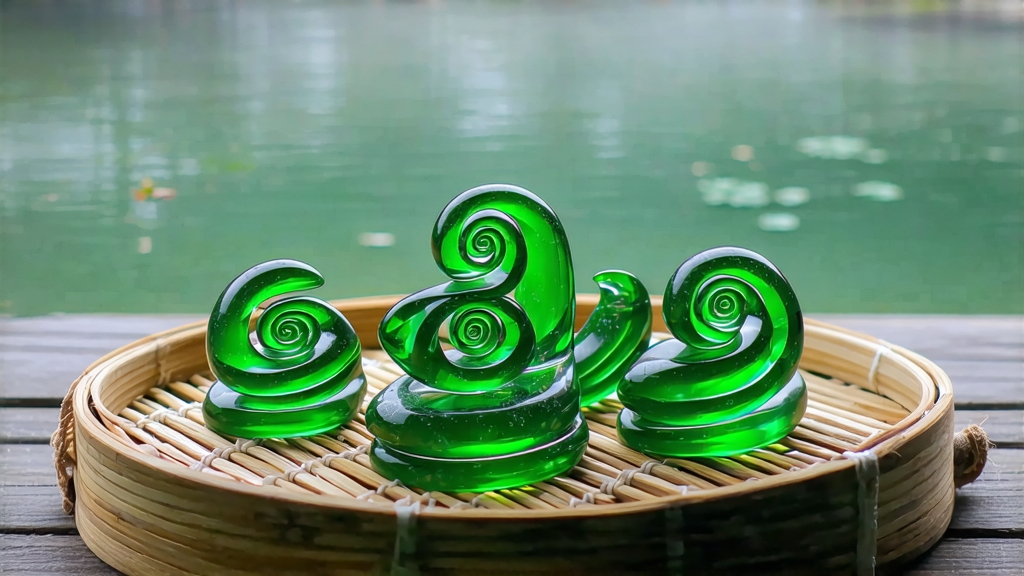
Tucked along the mist-lapped shores of Taihu Lake in Jiangsu province, Biluochun—literally “Green Snail Spring”—has been seducing tea lovers since the late Ming dynasty. Legend claims a tea picker ran out of basket space and tucked fresh shoots between her breasts; the warmth and floral proximity of wild peach blossoms infused the leaves with an unforgettable perfume. Whether apocryphal or not, the story captures the two qualities that define this celebrated green tea: an aroma so fragrant it once out-scented actual flowers, and a shape so tiny and tight it resembles a spiral shell.
History
Imperial records first mention Biluochun in 1699 when the Kangxi Emperor, touring the Lake Tai region, sampled the local tea and declared its taste “scarily fresh.” He renamed it from “Xia Sha Ren Xiang” (literally “scary fragrance”) to the more elegant “Biluochun,” honoring its snail-like curl and spring harvest. By the Qianlong era it had become tribute tea, couriered northward on horseback in lead-lined chests to preserve every whisper of aroma. European traders encountered it in Canton during the 1830s, mis-labeling it “Pi Lo Chun” in ship manifests, yet still managed to auction tiny lots in London for more than twice the price of Keemun black.
Terroir & Harvest Calendar
The authentic appellation is minuscule: Dongting East and West Mountains, two limestone islands rising from Taihu’s shallows. Here a subtropical lake climate traps morning fog, filtering sunlight into soft, shifting mosaics that slow photosynthesis and concentrate amino acids. Soils are acidic sandy loam rich in quartz and hornblende, minerals that sharpen the tea’s natural sweetness. Picking begins around Grain Rain (April 20) and lasts barely twenty days. Only the top bud plus the immediate leaf—called a “sparrow’s tongue”—is plucked before 9 a.m. while dew still pearls, ensuring minimal oxidation en route to the village workshop.
Varietal Nuances
Although all Biluochun comes from the same Camellia sinensis var. sinensis bushes, micro-elevation and clonal selection create three recognized grades:
1) Supreme Jade (Qianliang Cha): 6,000 buds yield 500 g; needle-thin spirals downy in silver-white.
2) First Grade Spring (Tou Chun): slightly larger curl, still monochromatic green, harvested in the first week.
3) Late Mist (Yu Qian): picked after early May, broader leaf, paler liquor, yet still intensely floral.
A fourth, modern “Forest Bi-luo” experimentally grows the cultivar under fruit trees—peach, plum, loquat—amplifying the original legend’s floral imprint.
Crafting the Spiral
Within minutes of plucking, the fragile buds are spread on bamboo trays set five metres above a gentle charcoal fire. This “kill-green” phase lasts only 40–50 seconds; the tea master tosses the leaves by hand, feeling for the sudden slackening of moisture when cell walls collapse but chlorophyll remains intact. Immediately afterward comes the unique coiling step: the still-hot leaves are rolled against a wire-mesh drum rotating at 28 rpm. Centrifugal force plus wrist pressure twists each bud into a tight spiral while microscopic hairs along the leaf edge fray, creating the signature silvery down. A second, lower-temperature firing (60 °C) locks in the curl and reduces residual moisture to 4 %. From 5 kg of fresh buds the yield is barely 1 kg of finished tea, explaining why top lots retail for over US $1,000 per 500 g.
Chemistry in the Cup
Biluochun’s olfactory punch stems from an unusually high ratio of linalool and geraniol—volatile terpenes more common in oolong. Coupled with 4.2 % theanine and only 12 % catechin, the tea delivers sweetness first, followed by a cool, mint-like finish that Chinese tasters call “returning sweet.” Microscopic examination of the down reveals hollow trichomes that act as aroma capillaries, releasing scent only when struck by 80 °C water.
Brewing Ritual for the International Table
Water: Filtered, low mineral (<50 ppm), 80 °C.
Leaf: 3 g (≈1 heaping teaspoon) per 120 ml.
Vessel: Clear glass gaiwan or tall cylindrical glass to watch the “dance of the spirals.”